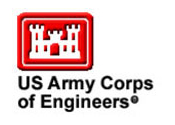
Agencies accelerate action in response to new test results suggesting Asian carp presence in Calumet Harbor – U.S. Army Corps of Engineer
FOR IMMEDIATE RELEASE
January 19, 2010
CONTACTS:
Lynne Whelan (USACE-Chicago)- (312)846-5330
Jacqueline Ashmon (USACE) – (513)684-3010
Phillippa Cannon (USEPA) - (312)353-6218
Chris McCloud (IDNR) - (217)785-0075
Ashley Spratt (FWS) – (612)713-5314
(Chicago) – The multi-agency Asian Carp Regional Coordinating Committee (RCC) has received information from the University of Notre Dame about one positive environmental DNA result for silver carp in Calumet Harbor approximately one-half mile north of the Calumet River and one more at a location in the Calumet River north of O'Brien Lock. These samples were collected on December 8 and recently processed. Two previous tests of multiple water samples from this area were negative.
Dr. David Lodge, director of the eDNA project at the University of Notre Dame, said that only a portion of the samples collected have been analyzed, but he cautioned that there is no known correlation between the number of positive samples and the quantity of Asian carp. "Our current eDNA process provides indications of likely presence, but it does not yet provide information about Asian carp quantity that may be present, age, size, how they got there or how long they may have been there," said Lodge. Lodge further iterated that if Asian carp are present it is vital to keep the barriers operating in a continued defense. "It is important to keep additional fish from migrating into the lake to lower the possibility that a self-sustaining population will result," said Lodge.
"Clearly this is not good news," said Major General John Peabody, Commanding General of the U.S. Army Corps of Engineers' Great Lakes and Ohio River Division. "But eDNA technology provides the advanced warning of the possible presence of Asian carp, so that all agencies supporting the RCC can focus their efforts and resources to optimal effect. The Corps of Engineers will continue to collaborate with our partners to urgently execute already planned actions, and further develop other multi-agency measures that will defeat this threat to the Great Lakes," said Peabody.
The Regional Coordinating Committee (RCC) is comprised largely of agencies that participated in last month's successful "rapid response" action. It is now working to respond to the most recent eDNA results, including consideration of:
- Rapid deployment of intensive netting, including electrofishing and specialized netting alternatives, in the area near O'Brien Lock to reduce the possibility that a self-sustaining population might be established.
- Continued research into scientific advances to apply detection systems that will allow participating agencies to pinpoint the exact location and numbers of carp. Current eDNA testing does not yet provide this information.
- Planning to develop the concept of how existing structures, such as locks, could be operated in a way that would minimize the risk of carp migration while the U.S. Coast Guard, local public safety and emergency responders, needed cargo, and other traffic transits the waterway;
- Expedited construction of new electric dispersal Barrier IIB to complement existing barriers, and severance of culverts and other bypass routes in the event of flooding, that might allow carp entry from adjacent waterways. Interim obstructions will be completed this year;
- Accelerate development of possible biological controls for Asian carp; and
- Continued efforts to assess "ecological separation" as a long-term strategy that blocks invasive species from transferring between the Great Lakes and Mississippi River watersheds while still allowing cargo and "clean traffic" to pass, leveraging the Corps of Engineers' Great Lakes and Mississippi River Interbasin Transfer Study.
"The IDNR is committed to working with all of our partners in the coming weeks and months by using conventional sampling methods in the Chicago waterway system and near shore areas of Lake Michigan to help determine locations and abundance of Asian carp and try to confirm this new Environmental DNA evidence," said John Rogner, Illinois Department of Natural Resources Assistant Director.
Participating agencies will continue using eDNA and other monitoring methods to provide early warning about possible Asian carp presence. The cooler water during the winter months reduces the likelihood of Asian carp detection because of reduced algae and other food sources, and fish tendency to slow down their activity and reside in deeper waters. With decreased metabolism Asian carp are less active and, therefore, harder to detect. Still, participating agencies continue to view their top priority as keeping Asian carp from becoming established in Lake Michigan.
"From what we have seen in other parts of the country, Asian carp could out-compete our native, sport and commercial fish in southern Lake Michigan," said Charlie Wooley, Deputy Regional Director, U.S. Fish and Wildlife Service. "We call them an aquatic vacuum cleaner because they filter important food resources out of the water and turn it into carp biomass," said Mr. Wooley.
"The Service remains committed to supporting our partners by assisting in intensified field monitoring and focused fish sampling, exploring new methods of Asian carp control, and engaging community stakeholders."
"Defeating Asian carp will require working together," said Cameron Davis, senior advisor to U.S. Environmental Protection Agency Administrator Lisa P. Jackson on Great Lakes issues. "We have a strong, committed team in place that acted collaboratively and successfully during December's rapid response action. That's what it will take now."
"The Great Lakes Fishery Commission has more than 50 years experience controlling the invasive sea lamprey" said Dr. Michael Hansen, chair of the commission. "The commission fully recognizes the necessity to prevent Asian carp from establishing populations in the Great Lakes and strongly supports the efforts of the participating agencies to this end."
Additional information about the recent sampling efforts is available on the Army Corps of Engineers' website at www.lrc.usace.army.mil.
